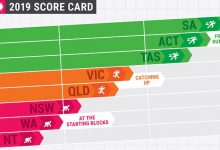South Australia has been named Australia’s leader on the transition to renewables as the deepening divide between Australia’s states and territories on one hand, and the federal government on the other, features strongly again in the 2019 renewables score card from the Climate Council.
The State of Play: Renewable Energy Leaders and Losers report, published for the fifth year running on Monday, gives up all hope of the current federal government seeing the light on the shift away from fossil fuels, and instead calls on state and territory governments to go it alone.
The Morrison Coalition government is chided not just for failing to lead on clean energy, but for deliberately obstructing progress.
“Without a consistent and stable policy environment the federal government is undermining the future pipeline of Australian projects,” said Climate Councillor and former ARENA chief Greg Bourne.
“It is time for all states and territories to create their own forums for coordination and move on without the federal government,” he said.
Of course, many states are, in effect, already doing just that – and leading this pack, rather ironically, is South Australia’s Liberal Marshall government.
The Climate Council names South Australia as overall winner in this year’s Report Card, calling the state a global leader in transitioning to a grid with a high share of wind and solar.
South Australia, like the ACT and Tasmania, already sources more than 50 per cent of its electricity from renewable energy resources – S.A., in fact, ranks third on this metric, at 51.2%, compared to 54.1% for the ACT and 94.6% for Tassie.
But it is the state’s leading role is “solving the physical supply and demand challenges” of a high renewables grid, that won it top honours this year.
“South Australia is building and integrating storage projects such as the world’s largest grid scale battery, synchronous condensers, and a new interconnector to New South Wales,” the Climate Council report says.
“It is also building a renewable hydrogen industry to turn surplus renewable power into stored hydrogen for transport fuels and to help balance the grid.”
South Australia energy minister, Dan van Holst Pellekaan, welcomed the recognition for his state, pointing to policies including the $200 million Home Battery Scheme, the $50 million Grid Scale Storage fund and $30 million Demand Management trials as crucial to its success.
“In partnership with industry, the Marshall government is creating the jobs of the future by leading the nation in the transition to cheaper more reliable renewable energy,” van Holst Pellekaan said on Monday.
“The cost of electricity is embedded in virtually everything we produce and the delivery of cheaper, more reliable electricity will give South Australian goods a significant advantage in local, national and international markets.”
 Victoria, meanwhile, won this year’s “rising star” award for having the most substantial pipeline of large-scale wind and solar projects of any state or territory.
Victoria, meanwhile, won this year’s “rising star” award for having the most substantial pipeline of large-scale wind and solar projects of any state or territory.
This achievement has no doubt been driven by a state government that has written its renewable energy targets into law, including the newly legislated 50 per cent by 2030 goal.
Victoria’s Andrews Labor government – which was re-elected late last year in a landslide victory – has also held auctions for new large-scale renewable energy generation and storage capacity, and has introduced planning rule changes and guidelines to smooth the way for development.
Dishonourable mentions went mostly to the federal government, but the Northern Territory also made the Climate Council’s naughty list in 2019 for getting the wooden spoon for the fifth year in a row, despite its tremendous – and much talked about – renewable energy potential.
The NT was the talk of the renewable energy industry last week for the completion of a capital raise for the massive Sun Cable project, that aims to link what would be a 10GW solar farm to energy customers in Singapore, via an undersea cable. But otherwise it has been extremely slow out of the blocks on both clean energy development and policy.
“Fortunately, we are seeing some progress from the Territory, which recently announced a draft aspirational target for net zero emissions by 2050,” climate councillor Andrew Stock said in comments.
“While this is an important step in the right direction, the draft plan supports the expansion of the Territory’s gas and fracking industries, which is incompatible with achieving net zero emissions and effectively tackling climate change,” he said.







